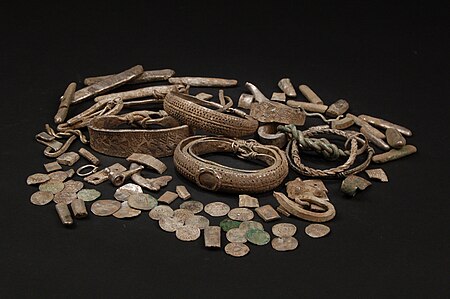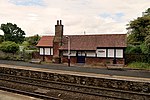Silverdale Hoard

The Silverdale Hoard is a collection of over 200 pieces of silver jewellery and coins discovered near Silverdale, Lancashire, England, in September 2011. The items were deposited together in and under a lead container buried about 16 inches (41 cm) underground which was found in a field by a metal detectorist. It is believed to date to around AD 900, a time of intense conflict between the Anglo-Saxons and the Danish settlers of northern England. The hoard is one of the largest Viking hoards ever discovered in the UK. It has been purchased by Lancashire Museums Service and has been displayed at Lancaster City Museum and the Museum of Lancashire in Preston. It is particularly significant for its inclusion of a coin stamped with the name of a previously unknown Viking ruler.
Excerpt from the Wikipedia article Silverdale Hoard (License: CC BY-SA 3.0, Authors, Images).Silverdale Hoard
Bank House Lane, Lancaster Silverdale
Geographical coordinates (GPS) Address Nearby Places Show on map
Geographical coordinates (GPS)
| Latitude | Longitude |
|---|---|
| N 54.17 ° | E -2.83 ° |
Address
Bank House Lane
Bank House Lane
LA5 0RE Lancaster, Silverdale
England, United Kingdom
Open on Google Maps










